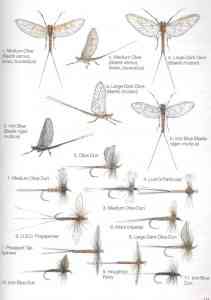
Fly fishing is a popular game in western countries. A real or artificial fly is used along with the hook for catching fish in fly fishing method. In fly fishing, the hook is customized in such a way that the whole thing resembles a beautiful fly or insect. Artificial flies come out in wide varieties of colours sizes and shapes. Some are used for top-water, some for deeper.
I have asked many fly fishing experts if flies are applicable to our native species. They have made very positive remarks on it. According to the experts, fly fishing may open a great door to game fishing in this subcontinent. Fly fishing is widely practiced in India, Nepal and Bhutan. Particularly for catching trouts and mahseers.
It is true that fishes largely live on aquatic insects, larvae etc in natural conditions. So, it is highly recommend to use the flies that are available in that particular environment. Use of live cockroach for catching some predatory species like Murrells, Snakeheads, Chitals as well as Mrigals is very common in our country. Many of our elders preferred cockroach for catching wallago attu too. By large this can also be considered as fly fishing.
We sometimes use wasp larvae for catching rohu, mrigal and calabasu. It is widely used in our villages for catching Climbing perch ( কৈ মাছ ) and Indian torrent catfish ( শিং মাছ ). We have seen many village-people using dragonflies and hoppers inside fish-traps (মাছের চাই). Their knowledge amazed me when I asked them the reason of using dragonflies inside those fish-traps. They told me that those dragonflies spread a very distinctive smell which attracts fish to come inside the traps. We know, pheromone is a special chemical compound mainly found in insects and other animals which attracts the females to males or vice versa during the mating seasons. And fishes are blessed with an extraordinary smelling sensor. It is not impossible that fishes are attracted to phenomenon which our elders knew for generations.
Many native anglers in Bangladesh use spiders as their baits. Some of our local species like murrells, snakeheads and climbing perch are mad about spiders. So, anything that resembles spiders or wasp larvae can be taken to experiment in our local waters.

Now, if we think about the natural feeding habits of our local carp species, we will come into a conclusion that a large portion of their feedings depend on insects. They feed on different varieties of insects available in the different levels of water. Some even come to the surface of the water to catch a fallen fly or insect. Some, bottom level fishes delightfully feed on larvae of different insects. In that case, a nymph can be used to target a bottom feeding species like rohu or mrigal.
Catlas are found to be moving from deep water to the surface water. They can be spotted quite easily by observing the water where they make splash. Putting a dry or wet fly on the areas where catlas are playing can be very effective. You may try it with a live cockroach or a dragonfly as well. The vibration created by a fallen cockroach or dragonfly on the water is irresistible for any type of fish. Grasshoppers and crickets are also very effective for bottom and mid level fishes. A slowly submerging grasshopper or cricket can bring you the catch of your lifetime.
The objective of this article is about giving you some unconventional ideas and approaches to game fishing in Bangladeshi perspectives. Angling is all about the combination of some basic principles and logic. So, whenever you are out for fishing and you are not getting expected response, why not try something different? Just look around and you will see a load of different but highly effective baits. It is the insect family, the largest as well as the most colorful family in the animal Kingdom.



Pingback: Fly Fishing in Bangladesh Explained - Angling in Bangladesh